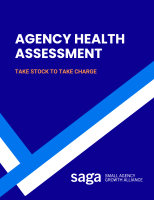Nothing drives your agency’s profitability more than getting your pricing right. That starts with deciding how you want to set your prices — not the amount, but the model that you will use to present your value proposition to potential clients.
You need to figure out:
- What pricing model to use
- How much to charge
- Which payment terms to accept
When it comes to models, there are many different approaches that you can take, and much of it depends on the specific services that you provide, who you provide them to, and how you can best convey the relationship between your work and the outcomes you produce.
Let’s look at the common models agencies use to price their services. You may end up choosing just one to focus on, or you may use a combination of them to best reach certain markets or to price certain services.
(For those of you expecting the typical discussion of “value pricing” here, you have come to the wrong place. That will be covered in a separate article because it is not a pricing model, but rather a philosophy of how to set the actual price for whatever model you choose.)
Billable Hours
Oh, the billable hour. How you have become much-maligned among agency growth gurus. The mere mention of the phrase has likely caused some of you to shiver as you develop the visceral negative reaction that you have been programmed to believe.
The reality is that while there is indeed much to dislike about billable hours, it remains a viable model that you should not reject out-of-hand. There is a time and a place for it.
Charging clients for every hour worked makes it much less likely that you will fall victim to profit leaks due to over-servicing and scope creep. It can make a lot of sense when you take on work that lacks clear definition up front. If you don’t know how long it will take to do what the client wants and needs, billable hours should be considered.
This article is not meant to be a treatise on the pros and cons of each pricing model, so we won’t explore every nook-and-cranny of the billable hour, but if you set your rate(s) right and accurately track your time, billable hours can work for both you and your client.
Project-Based
One of the most common pricing models in the agency world today is project-based fees. You clearly define a scope of work for something — an event, a website, a product launch, etc. — and attach a specific price to it.
The trick here is to get your time estimates right — and include a buffer for the scope creep and you-might-as-wells that come up along the way.
Most clients like project-based pricing because they know exactly what something is going to cost and what they are going to get for their money. There are no long-term commitments involved and little or no ambiguity over budget.
Agencies can do quite well with this model, too, as it gives flexibility to price future projects better if you get time estimates (and thus profitability) wrong on one project. The downside is that it provides low predictability for ongoing revenue streams.
Buckets of Hours
Selling buckets of hours represents a blend of hourly billing and fixed-fee projects. With this model, a client would buy a block of hours for a defined cost.
Sometimes this might come in the form of “I’ll buy 100 hours for $XYZ” but it might also be in the form of buying a 1- or 2-week “sprint” or some similar unit of hours measurement.
Buckets of hours can be sold as one-time or recurring packages.
This approach gives both parties a clear understanding of how much they will need to invest, but it leaves open-ended the results that will be produced. It tends to work best when the agency is augmenting internal staff to provide additional support or when the goals and objectives are poorly defined.
Fixed-Fee Retainers
The Holy Grail for many agencies is the monthly retainer. Agencies love the certainty of getting a set amount of money from a client each month. Clients love the budget certainty that they get, too.
Unfortunately, most retainer arrangements end up really poorly defined. They usually include some vague description of the services that will be provided, with the agency trying to frame expectations to mitigate the potential for scope creep.
Retainer relationships tend to start out as loss leaders for agencies, as they invest additional time at the start of the relationship to better understand the client and its needs. As the engagement continues, the agency’s staff becomes more knowledgeable and efficient, generating strong profit margins for that client. Somewhere along the way, though, the profit begins to dip as the agency becomes addicted to the monthly cash flow and fearful that it will go away so they begin to over-service the client.
The “solution” that some agencies have is to put a cap on the monthly hours included in the retainer, but then the retainer really becomes just a recurring buckets-of-hours contract. There’s nothing wrong with that, but it opens up additional discussions — like rollover hours, time reporting to the client, and other issues to consider.
Even before the 2020 Pandemic, many clients had been forcing agencies to move away from open-ended retainers to more defined, shorter-term engagements tied to results. That trend accelerated during the economic shock, and will likely continue into the future.
All-You-Can-Eat
Most of us have been to a restaurant buffet before. There are lots of choices and you wander around slopping food on your plate as you go. You don’t think all that carefully about what you choose because you know you can always go back for more and leave things you don’t like on your plate.
The price usually seems good since you can see how much is available, but then you sort of feel obligated to keep going up and eating more than you would have otherwise in order to get your money’s worth.
If the restaurant gets the buffet price right, they stand to make a killing — but that means customers likely leave feeling cheated. If the establishment gets the price wrong, they can get taken to the cleaners by diners who load their plates up with lobster and caviar.
Selling services in an all-you-can-eat format suffers from the same challenges. In recent years, more agency-style businesses have cropped up that offer certain types of services — like design or digital — in this buffet approach. They typically try to control “over-eating” by allowing only one specific task to be worked on at a time (like designing an image, editing a video, or producing a landing page).
If your agency deals in high-volume repeatable tasks for clients, a model like this can work, but pricing needs to be spot-on to ensure that neither party gets a bad case of indigestion.
Productized Services
Every agency tends to have a “sweet spot” or a set of services it typically offers to most clients for a similar price. Recognizing this, many agencies have begun to experiment with creating productized service offerings.
Instead of estimating and quoting projects specifically for an individual prospect, the agency bundles up a set of services and assigns a price to it. The productized approach can guide customized service discussions by using the set price description as an anchor, or it might be more of a take-it-or-leave-it option.
Agencies may resist productized offerings by saying that their work is much more bespoke, but I would challenge most of you to look at your last 10 client engagements and tell me that there’s not much overlap in scope of work and pricing — at least for portions of the work.
While productized service choices can help clients focus their understanding of the work that you do, there are some that may view you as more of a commodity offering, especially if the options are presented too soon in the discussion. You will need to carefully weight the pros and cons of this model, but it can be a very useful way to handle at least typical add-ons to your new or ongoing engagements.
Points-Based
Over the past decade or so, a new approach to pricing has gained a foothold among some agencies, particularly in the digital marketing space. Instead of selling buckets of hours on a one-time or ongoing basis, agencies give clients a set number of points for a fixed price.
These points can then be “redeemed” for specific items on a menu. Writing a blog post might be 100 points while posting to Twitter could be 5. A landing page might cost 250 points while an About Us page just 50.
Points enable you to move away from discussing billable hours, but it really is just a veneer for the same type of relationship. For clients with wildly varying needs from month to month — either in terms of the specific services required or the volume needed — points can be a viable solution.
Using a points-based approach to pricing has many of the same downsides of selling buckets of hours, but it also adds the need to educate prospects on the model since most clients haven’t experienced it before. Nevertheless, it could be a good solution for some agency-client relationships.
Pay-for-Performance
Clients increasingly focus on the results they get from agencies, so the pay-for-performance model has gained in popularity. In this approach, some or all of the agency’s compensation is tied to achieving certain goals — like generating traffic, sales, or leads.
The idea is that clients will pay a premium because they know that they will only pay for actual results that they need, so this puts more money in the agency’s pocket when they are successful. It does, however, transfer considerable risk to the agency. No results, no (or less) pay.
This model is much more popular for digital marketing and advertising agencies that have greater ability to track actual results in real-time. However, it has existing for decades even in more traditional agencies under different names. For example, some PR firms have had “success” or “placement” fees in place for scoring media hits in targeted publications. The ethics of these approaches have been hotly debated in the past, but now are much more accepted.
For agencies confident in their ability to deliver results and willing to shoulder additional risk, the pay-for-performance model can certainly be part of the arsenal. It requires careful vetting of prospective clients to make sure that there really is a good match, but that’s something that agencies should be focused on even if they work off of a different pricing model — it just introduces far more substantial consequences for getting the determination wrong.
(This is a topic that Gini Dietrich and I covered in a podcast episode, so give it a listen if you want more to consider.)
Percentage of Ad Spend
Advertising agencies have long been compensated in whole or in part based on how much a client spends on its buys. The compensation may come from the client or in the form of “discounts” (or kickbacks) from the publisher or broadcaster.
As more and more agencies — even old-school PR firms — get into the business of managing at least small-scale ad campaigns, especially in the digital world, questions crop up more frequently about how to get compensated for this work.
Pay-per-click and other online advertising firms have wrestled with how to get charge for their services. Should it be a fixed management fee, a set percentage of spending, or some combination of those two?
If your agency only offers advertising as a minor part of the client engagement, it may not make sense to worry about collecting a percentage of ad spend. Wrapping management costs (and therefore fees) into the overall engagement may be the best approach.
On the other hand, if there is a possibility or likelihood that your client will be increasing ad spending over the course of the engagement, it may be worth considering adding a percentage of the spend into your arrangement since it accounts for the additional work it may take to manage more ads in more places. The other advantage is that it gives your firm some additional potential upside in the client relationship without having to go back and ask for more money for certain services — something that many agencies are especially bad about.
Choosing the Right Model
There is obviously a lot to chew on here, and this article only scratches the surface of the ins and outs of each possible pricing model. You can also mix and match among them — or create new creative models based on the principles outlined.
The key to being successful is picking the model that allows you to best convey your value to a prospective client and get compensated fairly for your work.
You also need to remember that you are not Netflix or Amazon or the New York Times. Nobody is going to be reporting about changes to your prices or pricing model. You should remain flexible and feel free to make adjustments over time to ensure that you are maximizing the value you provide and the profits you generate.
Additional Resources
Listen to Chip and Gini discuss this article on the Agency Leadership Podcast.










